Time Machines for Investors
Investing is all about time traveling
April 2021. Reading Time: 10 Minutes. Author: Nicolas Rabener.
SUMMARY
- Investors are challenged when evaluating investment opportunities with limited track records
- Factor exposure analysis can be used to create replication portfolios
- These empower investors to walk backward and forward in time, enhancing the investment decision process
INTRODUCTION
Investing is all about time traveling. Most investors travel forward a few days, months, or even years, in order to take a snapshot of the landscape at that point in the future. They then travel back to the present time and position their portfolios accordingly. However, looking at the track record of these investors, which includes day traders, mutual fund managers, and global macro hedge funds, shows that time traveling is a treacherous business. The future they have seen was only one of an infinite number of universes.
A handful of investors have specialized in traveling forward for only extremely short time periods, less than a microsecond, studying the future order flows of other investors, mainly retail. These futures are more certain and can be exploited with high-frequency algorithms.
Another type of investor prefers to travel backward in time by simulating how strategies would have behaved historically. Using high-quality data sets and realistic assumptions, quants can determine the attractiveness of almost any strategy. Some have gone back centuries. Unfortunately, being able to travel backward in time does not guarantee that a strategy will also be profitable in the future.
One underrated form of time traveling in finance is via factor exposure analysis. This methodology has been used by investors primarily to explain the returns and risks of investment portfolios. However, it can also be used by investors to travel forward and backward in time, almost like a time machine, which we showcase in this research note.
BASIC FACTOR EXPOSURE ANALYSIS
Investors have been using factor exposure analysis to explain the performance of investment portfolios for decades. The most common use case is to identify if a mutual fund manager has generated true alpha, or if his or her excess returns can be attributed to common equity factors like value or momentum (read Alpha Generation: The Search for the Unexplainable).
Naturally, the same process can be run at the asset class level. We use the largest asset allocation ETF traded in the US, the iShares Core Growth Allocation ETF (AOR) with close to $2 billion of assets under management, as a case study.
Running a regression-based factor exposure analysis reveals significant positive exposure to stocks and bonds, which is expected given the multi-asset allocation strategy. There is also slightly negative exposure to equity factors and currencies, but that can be considered marginal given the magnitude. The R2 is 0.97, implying that the regression model has high explanatory power.
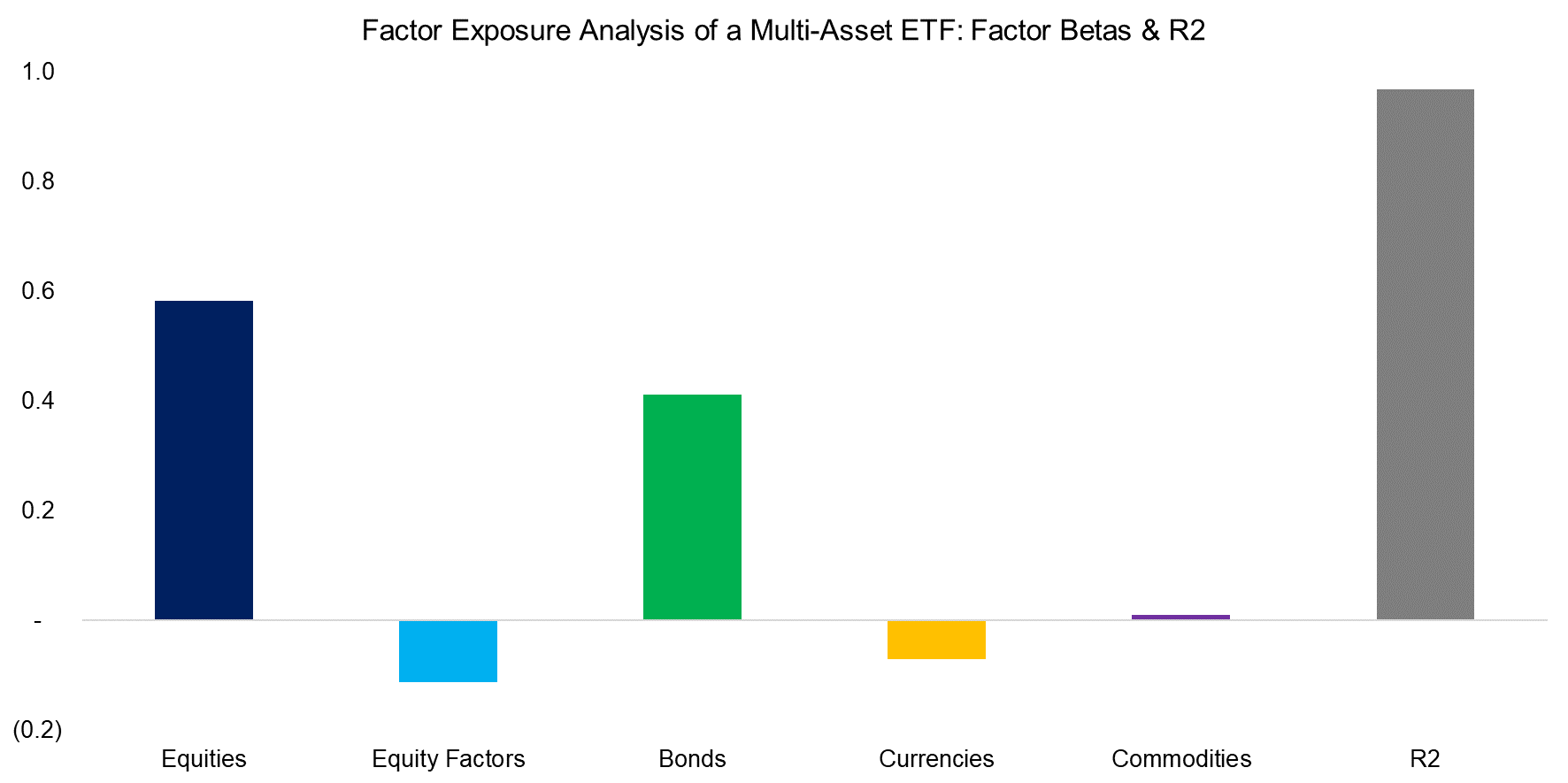
Source: FactorResearch
REPLICATION PORTFOLIOS VIA FACTOR EXPOSURES
We can use the factor betas from the regression analysis to recreate the history of the multi-asset ETF. An investor might question why a replication portfolio is needed as that ETF has a long track record. Although this is true in this particular case, there are many stocks that went public over the last couple of years, where investors have zero information on how these might have behaved across a complete market cycle.
Similarly, most mutual funds and ETFs offer limited track records. Bloomberg notes that the average lifetime of an ETF is a mere 3.4 years. This leaves investors without any indication of how these would have performed during periods of market stress, e.g. during the global financial crisis of 2008.
Creating a replication portfolio for the multi-asset ETF highlights that this is a good approximation in the decade between 2010 and 2020 (read Replicating Famous Hedge Funds).
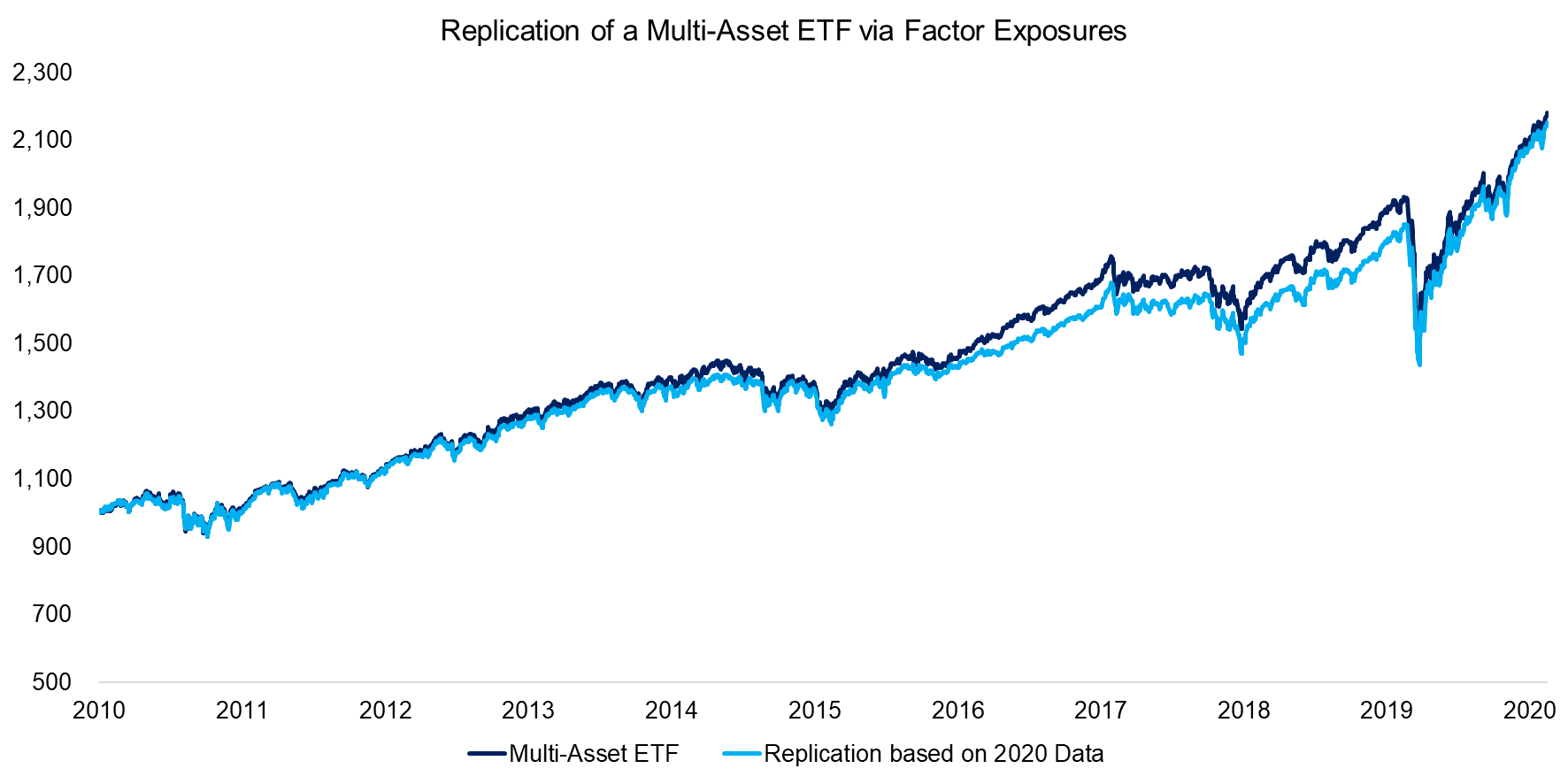
Source: FactorResearch
It is worth noting that a regression analysis requires multiple assumptions that all impact the R2 of the analysis and in general the robustness. The key assumptions are the selection of the independent variables, the choice of time-frequency, and the lookback period.
For example, we can simulate the significance of the lookback period by varying it from a one to five-year timeframe. The replication is only an approximation, like any model, and does not generate exactly the same returns as the multi-asset ETF. However, although there are some meaningful differences between realized and theoretical returns over the last year, they were almost identical over three, five, and ten-year periods.
For the avoidance of doubt, a one-year lookback means that the factor betas were based on a regression analysis that only used data from the year 2020, which may be considered the in-sample period from a statistical perspective. It is quite impressive that the 10-year history of the ETF was so closely replicated with only one year of data for determining the factor betas, and is further evidence of how persistent they are.
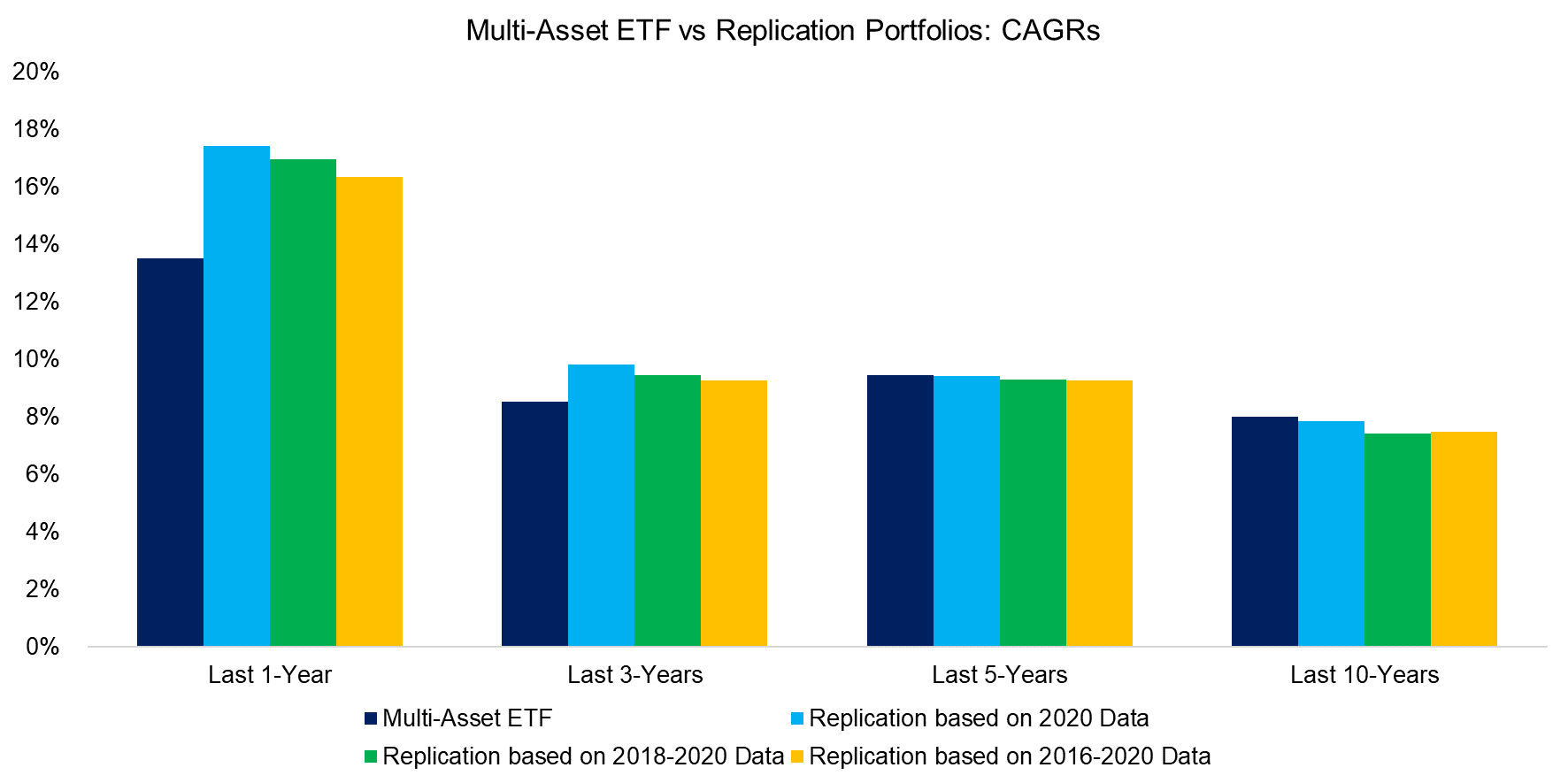
Source: FactorResearch
TRAVELING BACKWARD IN TIME
One of the advantages of the replication portfolios is that they empower investors to travel backward, even if the securities of an investment portfolio did not exist at that point in time. There are multiple use cases for this, like conducting economic scenario analysis, or testing how the investment product or portfolio would have performed during major periods of market stress.
The multi-asset ETF has a long track record and it is easy to calculate the returns during crisis periods over the last decade. However, when such data history is not available, which happens frequently, then a replication portfolio can offer highly valuable insights for the investment decision process.
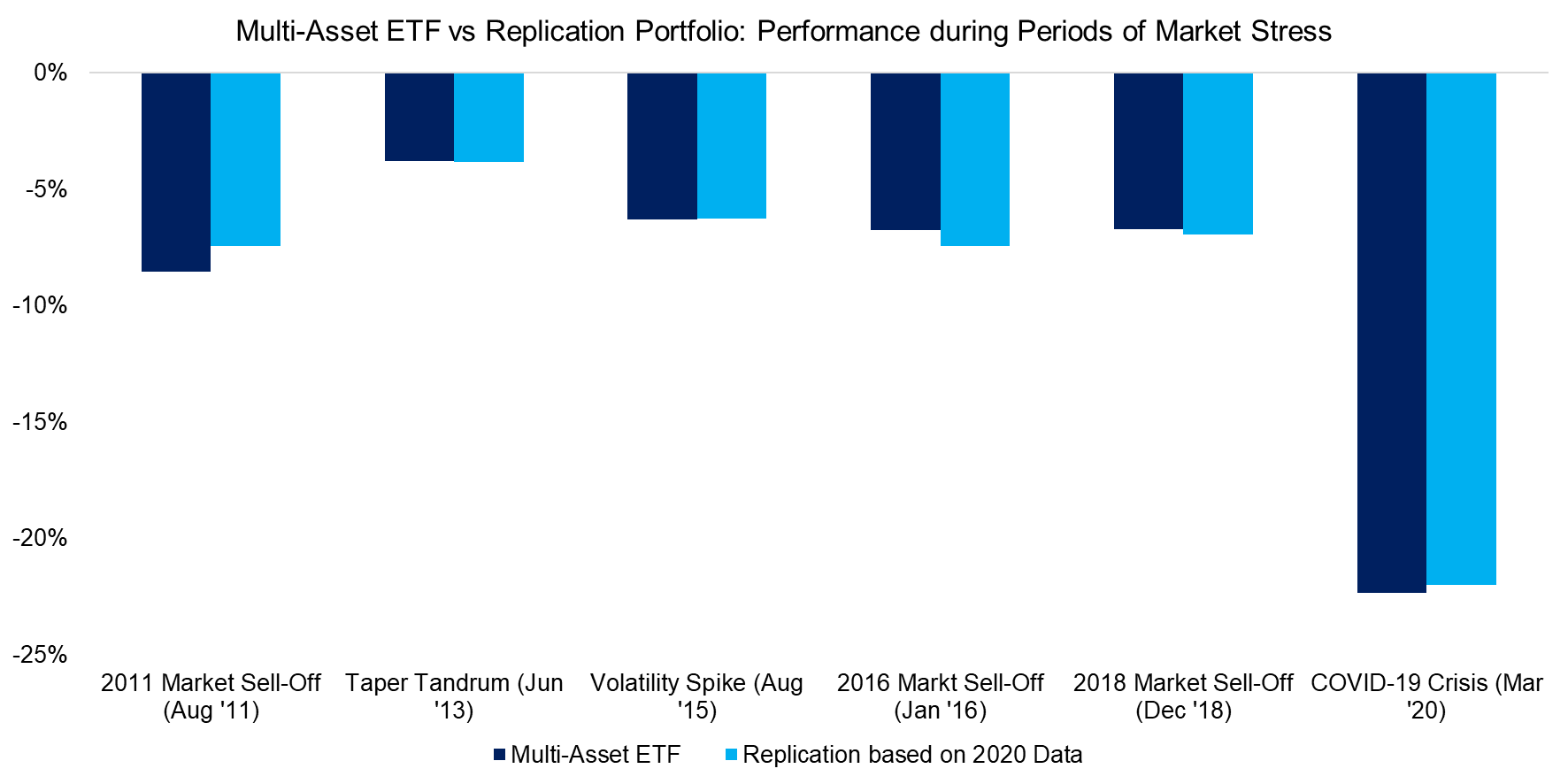
Source: FactorResearch
TRAVELING FORWARD IN TIME
The results of the factor exposure analysis can also be used to travel forward in time and get a perspective of expected returns. Large asset management companies and investment banks provide expected returns for a variety of asset classes for the next five to ten years, which they update on a regular basis throughout the year. These capital market assumptions can be combined with the results of the factor exposure analysis to create an expected return on portfolio level.
We highlight the expected annualized return of the multi-asset ETF for the next 10 years using the average, the lowest, and the highest return forecasts. We observe a large discrepancy between the pessimistic and optimistic cases, which highlights divergent views on asset class returns.
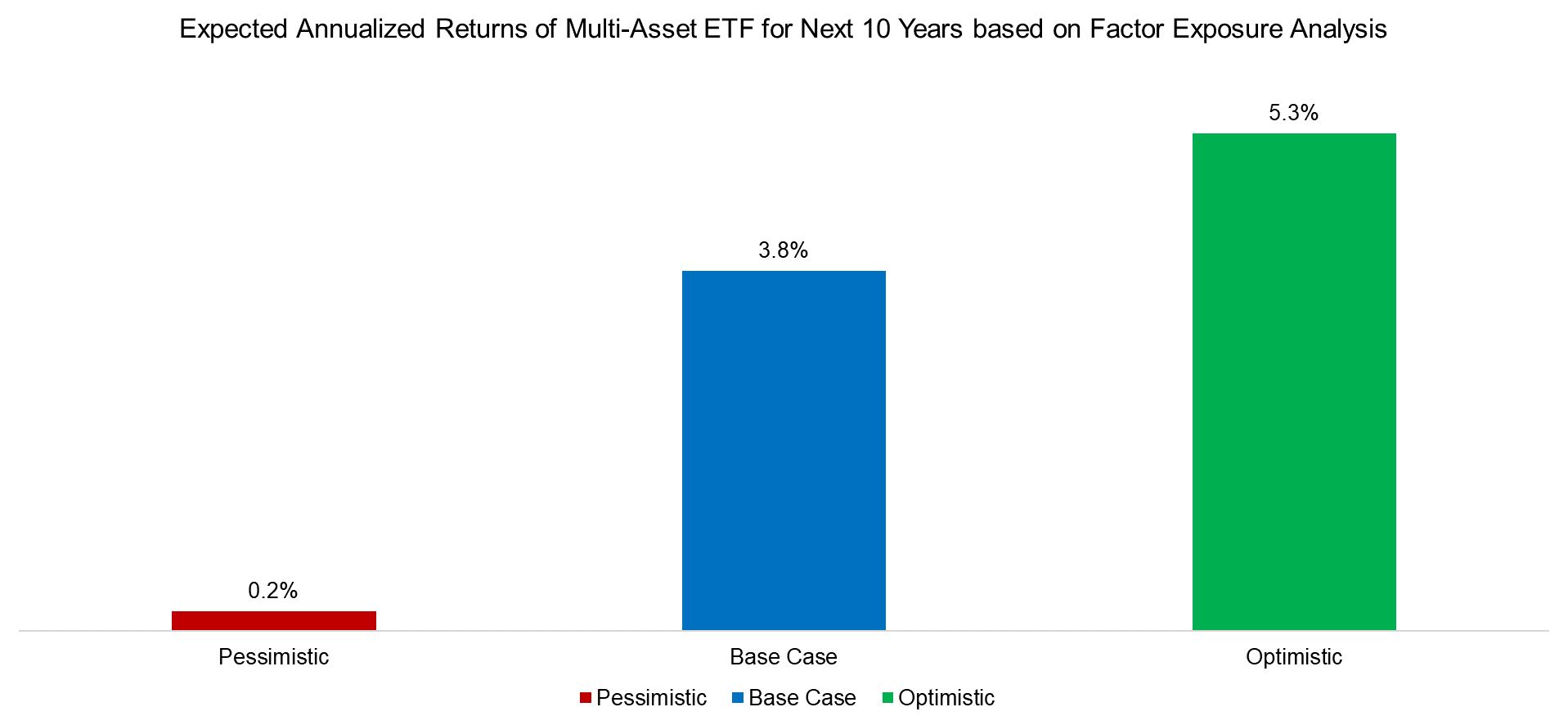
Source: Various asset managers & investment banks, FactorResearch
LIMITATIONS OF REPLICATION PORTFOLIOS
Unfortunately, this time machine, like all others, has its limitations. Companies constantly evolve and fund managers frequently change their investment style. If we use a three-year lookback in the regression analysis and a fund manager had a value tilt during that period, he or she will be categorized as a value fund. If the fund manager had a growth tilt five years ago, then this would be ignored in the replication portfolios.
We can demonstrate these limitations by replicating Berkshire Hathaway via factor exposure analysis, where we use a lookback ranging from one to five years. We observe a meaningful difference between the actual performance of the stock and the theoretical replication portfolios. Although the company can be considered almost like an equity mutual fund given its many investments, it still represents a highly concentrated portfolio that has experienced significant changes in recent years. Such changes can be captured if a factor exposure analysis was conducted at frequent intervals, but less effectively if run at only one point with a limited lookback period.
However, despite these limitations, we observe that even in the case of Berkshire Hathaway the replication portfolios exhibited the same trends as the stock over the last decade. If a long-term track record would not have been available, then the replication portfolios would still represent relevant proxies on how the stock would have performed during periods of market stress.
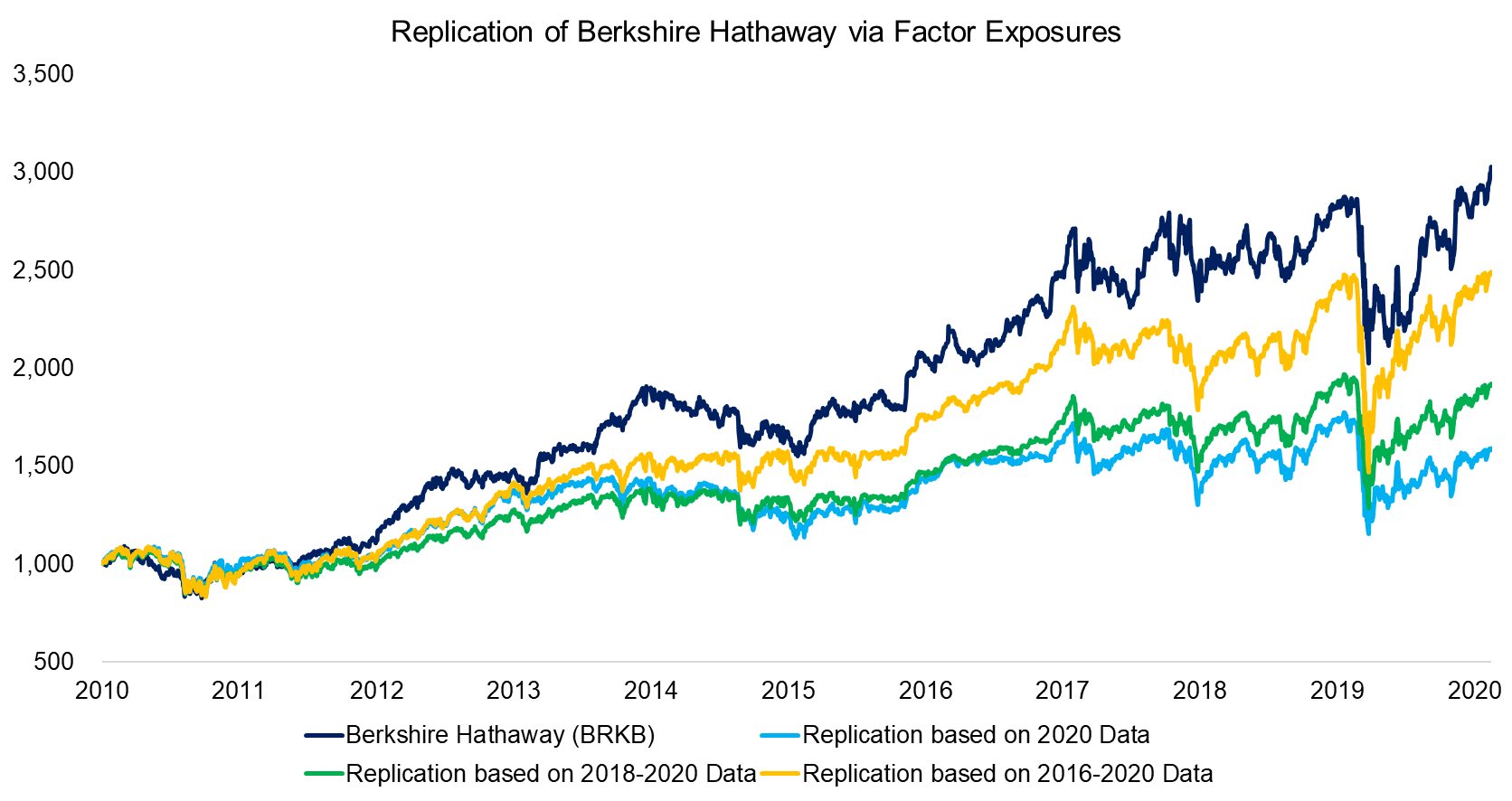
Source: FactorResearch
FURTHER THOUGHTS
Given the benefits of using factor exposure analysis to walk backward and forward in time, why is this approach not more popular?
One of the key reasons is that this time machine has quite a few nuts and bolts. A factor exposure analysis is theoretically simple, it is just a regression analysis after all, but practically complex. The process requires deciding on a methodology (plain, forward, Lasso, etc), having high-quality data sets (residualized & beta-neutral indices), and making assumptions that are not easy to make.
However, once built, it is quite powerful for improving the understanding of what has been driving the risks and returns of a portfolio as well as getting a perspective on expected returns.
RELATED RESEARCH
Factor Exposure Analysis 102: More or Less Independent Variables?
Factor Exposure Analysis 101: Linear vs Lasso Regression
Factor Exposure Analysis 100: Holdings vs Regression-Based
Factor Exposure: Smart Beta vs Mutual Funds
ABOUT THE AUTHOR
Nicolas Rabener is the CEO & Founder of Finominal, which empowers professional investors with data, technology, and research insights to improve their investment outcomes. Previously he created Jackdaw Capital, an award-winning quantitative hedge fund. Before that Nicolas worked at GIC and Citigroup in London and New York. Nicolas holds a Master of Finance from HHL Leipzig Graduate School of Management, is a CAIA charter holder, and enjoys endurance sports (Ironman & 100km Ultramarathon).
Connect with me on LinkedIn or X.

